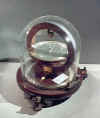|

Science
 Museum
Museum

 SM006
Tangent Galvanometer circa
1935 Electricity
SM006
Tangent Galvanometer circa
1935 Electricity
A
tangent galvanometer for measuring electric current consists of a magnetic
needle suspended at the
centre of
a vertical ring
through
which a current
flows, the plane of the ring coinciding with the magnetic meridian.
The earth’s magnetic field and the magnetic field due to the current
through the coil are at right angles and so a resultant couple acts on the
magnetic needle such that a deflection, q
results.
If the current is I, the earth’s field is H, then it can be shown that:

where

n
being the number of turns in the coil
r
being the radius of the coil
.
So

The tangent galvanometer can measure large currents
where n is small and small currents when n is large (about 500 turns).
If r is made smaller, the sensitivity is higher but for a uniform
magnetic field from the coil, its diameter must be about 12 times the length of
the magnet.

|
![]()
 Museum
Museum
![]()
 SM006
Tangent Galvanometer
SM006
Tangent Galvanometer![]()

![]()
![]()